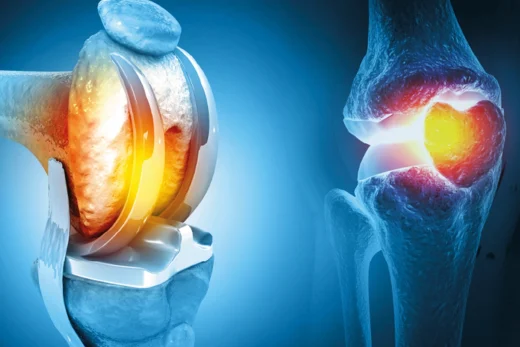Knee replacement surgery was once seen as a procedure reserved for the elderly typically individuals in their late 60s or 70s whose joints had reached the end of the line after decades of wear and tear. But that image is rapidly changing. Today, a growing number of younger patients, active adults, former athletes, and even people in their early 40s are turning to knee replacement surgery as a proactive solution to chronic pain and limited mobility.
So, what’s driving this shift toward earlier intervention? The answer lies at the crossroads of lifestyle, sports culture, and an evolving understanding of arthritis and joint preservation.

The New Face of Knee Replacement: It’s Getting Younger
It’s no longer uncommon to see marathon runners, former football players, or yoga enthusiasts considering knee replacement long before they reach retirement age. Recent data from orthopedic registries across the UK and US show a steady increase in the number of knee replacements being performed on people aged 45 to 60. In some private medical tourism hubs like Turkey, the trend is even more pronounced, with international patients often seeking earlier, life-enhancing intervention before their condition becomes disabling.
Why the Shift? Understanding the Drivers of Earlier Surgery
1. Sports Injuries Accumulating Over Time
From high school athletes to weekend warriors, active individuals are at higher risk of developing post-traumatic osteoarthritis, a type of joint degeneration caused by previous injuries like torn ligaments, meniscal damage, or cartilage wear. While these injuries may heal, they often leave subtle imbalances that slowly damage the joint surface over time.
By their 40s or 50s, many former athletes begin to experience daily stiffness, swelling, and grinding sensations in the knees, classic signs of arthritis. And in some cases, the damage is severe enough that conservative treatments no longer provide relief.
2. People Are Living and Staying Active Longer
We’re not just living longer; we’re expecting more from our bodies well into our 60s, 70s, and beyond. Retirement doesn’t mean slowing down anymore; it often means traveling, hiking, biking, and staying socially active. For individuals whose knee pain is compromising these goals, surgery becomes less about age and more about quality of life.
3. Better Implants, Better Outcomes
One reason knee replacements were traditionally delayed was concern about the lifespan of the prosthetic joint. Earlier implants typically lasted 10–15 years, meaning that younger patients faced the prospect of a risky revision surgery later in life.
Today, thanks to advanced implant materials, robotic-assisted precision, and better post-op rehabilitation, many modern knee replacements are expected to last 20–25 years or more. For active adults, that’s a game-changer.
4. Awareness and Access to Medical Tourism
With the rise of global health platforms, more patients are learning about high-quality, affordable knee replacement options abroad especially in countries like Turkey, where world-class care can be accessed at a fraction of the cost compared to the US or UK.
Hospitals such as Erdem Hospital in Istanbul are seeing increasing demand from international patients aged 40–60 who are looking for long-term relief without breaking the bank. With English-speaking care coordinators, modern facilities, and orthopedic surgeons trained in Europe and the US, Turkey is leading the way in global orthopedic solutions.
How Arthritis Accelerates Joint Damage in Active Adults
There are over 100 forms of arthritis, but the most common in active adults is osteoarthritis, a degenerative joint disease that gradually wears down the cartilage protecting the bones.
In athletes or highly active individuals, the knee joint is repeatedly stressed. While this can strengthen muscles and bones, it also increases the risk of microscopic injuries that accumulate over time. These “microtraumas” can trigger inflammation, joint misalignment, and uneven pressure across the cartilage. Over years or decades, this leads to cartilage breakdown and bone-on-bone contact.
Once the cartilage is gone, no amount of physical therapy or medication can restore it. That’s when surgical options like knee replacement become necessary not just to eliminate pain, but to prevent further deformity and instability.
Early Surgery vs. Waiting
Choosing Knee Replacement Earlier:
Pros:
- Faster recovery while younger and more resilient
- Return to an active lifestyle sooner
- Prevents further joint deformity
- Reduces need for long-term pain medications
- Restores quality of life during prime working or parenting years
Cons:
- Possibility of needing a revision surgery later in life
- Requires post-op commitment to physical therapy and care
- Some insurance providers may not cover early interventions without advanced degeneration
In comparison, waiting for surgery can prolong suffering and lead to muscle atrophy, increased joint stiffness, and loss of mobility making the eventual surgery and recovery harder.
Who Is a Candidate for Early Knee Replacement?
Knee replacement isn’t about age, it’s about symptom severity, lifestyle, and joint damage. Surgeons may consider a patient for early surgery if:
- Knee pain limits daily activities like walking, standing, or sleeping
- There’s visible deformity or joint instability
- Imaging shows advanced cartilage loss
- Conservative treatments (injections, therapy) have failed
- The patient is in good general health and motivated to recover
Patients in their 40s and 50s often recover more quickly due to stronger muscles, better healing response, and higher post-op activity levels leading to excellent long-term results.
What the Journey Looks Like
A typical knee replacement journey involves the following steps:
- Initial Consultation and Imaging
The orthopedic surgeon will assess your symptoms, mobility, X-rays, and MRIs to determine the extent of damage. - Preoperative Optimization
Blood tests, ECG, and other screenings are done to ensure safe anesthesia. Patients may be asked to strengthen leg muscles beforehand through “prehab.” - Surgery Day
The procedure usually lasts 1–2 hours. Most patients stay in the hospital for 2–4 days, depending on the country and technique used. - Rehabilitation Phase
Physical therapy begins within 24 hours and continues for several weeks or months. Recovery milestones vary, but most people return to work in 4–8 weeks and resume recreational activities within 3–6 months. - Life After Surgery
Modern knee replacements allow for walking, cycling, hiking, and even low-impact sports like swimming or golf. High-impact sports (e.g., running, basketball) may be limited to protect the joint.
Why More Patients Are Choosing Knee Replacement in Turkey

Turkey has become a destination of choice for early knee replacement surgery thanks to its blend of affordability, surgical quality, and comprehensive care packages.
At Erdem Hospital, patients benefit from:
- Minimally invasive or robotic-assisted techniques
- Internationally certified orthopedic surgeons
- Short waiting times
- All-inclusive medical tourism packages (including hotel stay, transportation, physical therapy, and follow-up)
Many patients arrive for a one-week stay that includes pre-op consultation, surgery, and initial recovery, followed by virtual rehab guidance after returning home.
The Bottom Line: Don’t Let Age or Fear Hold You Back
If you’re living with knee pain that limits your life, waiting for it to get worse may not be the answer. With advancements in surgical techniques, longer-lasting implants, and a growing global movement toward early intervention, knee replacement is no longer the “last resort” for old age it’s a proactive step toward a better, freer life.
Your age shouldn’t dictate your ability to move, play, or live fully. For many, choosing knee replacement earlier isn’t just a medical decision it’s a life decision.
Interested in exploring early knee replacement surgery abroad?
Contact Erdem Hospital in Istanbul for a personalized consultation and take the first step toward walking without limits.